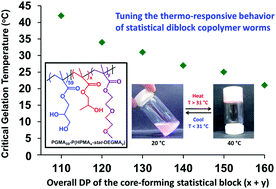Tuning the critical gelation temperature of thermo-responsive diblock copolymer worm gels†
Abstract
Amphiphilic diblock copolymer nano-objects can be readily prepared using reversible addition–fragmentation chain transfer (RAFT) polymerization. For example, poly(glycerol monomethacrylate) (PGMA) chain transfer agents (CTA) can be chain-extended using 2-hydroxypropyl methacrylate (HPMA) via RAFT aqueous dispersion polymerization to form well-defined spheres, worms or vesicles at up to 25% solids. The worm morphology is of particular interest, since multiple inter-worm contacts lead to the formation of soft free-standing gels, which undergo reversible degelation on cooling to sub-ambient temperatures. However, the critical gelation temperature (CGT) for such thermo-responsive gels is ≤20 °C, which is relatively low for certain biomedical applications. In this work, a series of new amphiphilic diblock copolymers are prepared in which the core-forming block comprises a statistical mixture of HPMA and di(ethylene glycol) methyl ether methacrylate (DEGMA), which is a more hydrophilic monomer than HPMA. Statistical copolymerizations proceeded to high conversion and low polydispersities were achieved in all cases (Mw/Mn < 1.20). The resulting PGMA-P(HPMA-stat-DEGMA) diblock copolymers undergo polymerization-induced self-assembly at 10% w/w solids to form free-standing worm gels. SAXS studies indicate that reversible (de)gelation occurs below the CGT as a result of a worm-to-sphere transition, with further cooling to 5 °C affording weakly interacting copolymer chains with a mean aggregation number of approximately four. This corresponds to almost molecular dissolution of the copolymer spheres. The CGT can be readily tuned by varying the mean degree of polymerization and the DEGMA content of the core-forming statistical block. For example, a CGT of 31 °C was obtained for PGMA59-P(HPMA91-stat-DEGMA39). This is sufficiently close to physiological temperature (37 °C) to suggest that these new copolymer gels may offer biomedical applications as readily-sterilizable scaffolds for mammalian cells, since facile cell harvesting can be achieved after a single thermal cycle.


 Please wait while we load your content...
Please wait while we load your content...